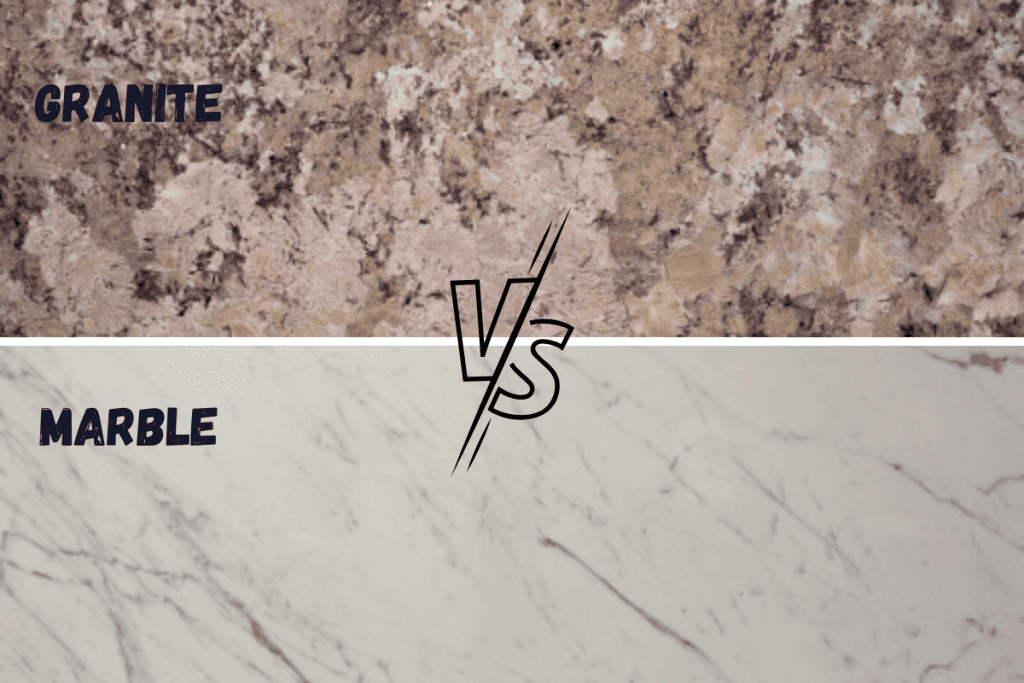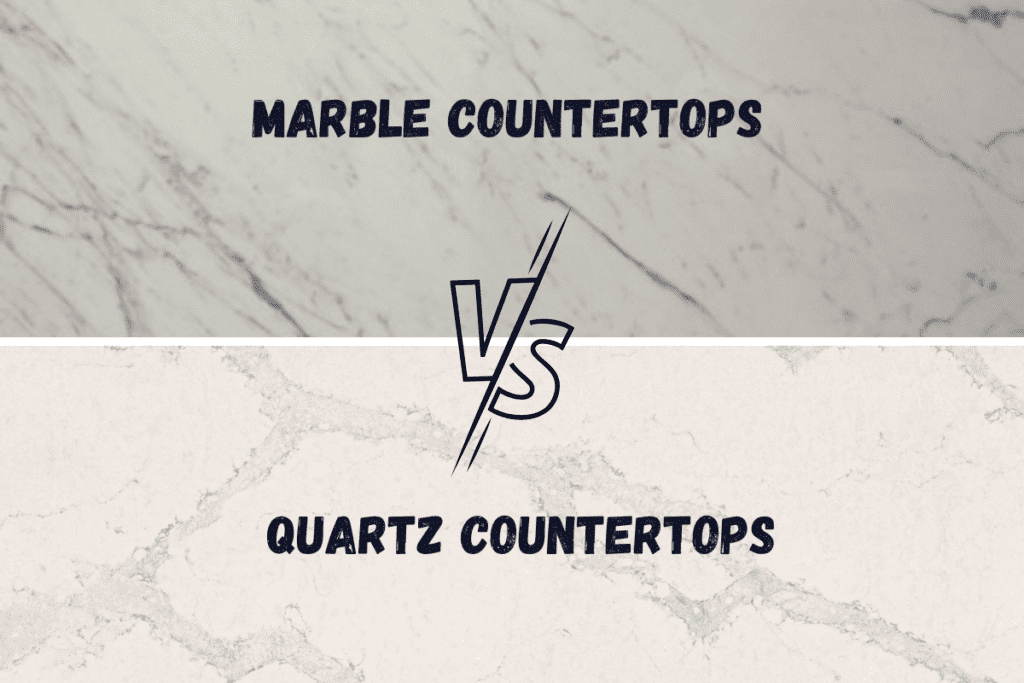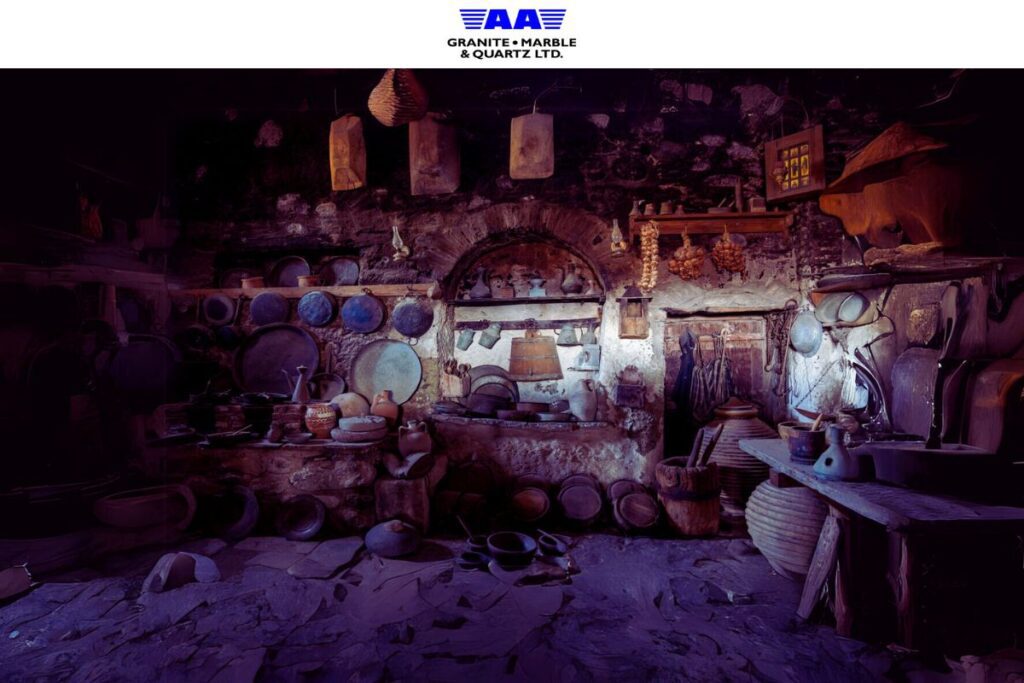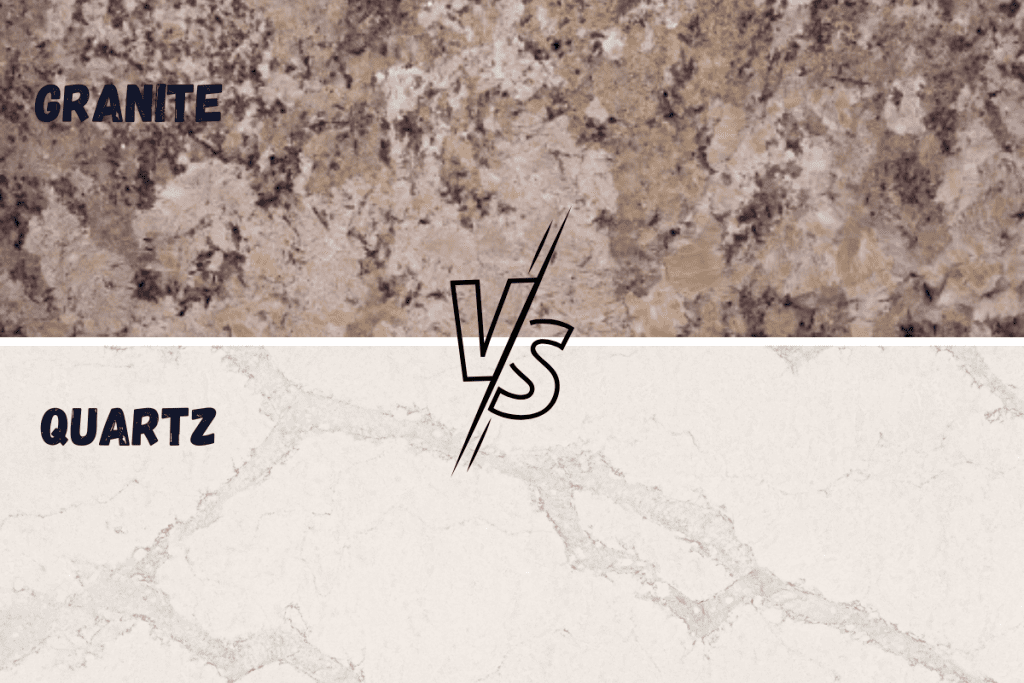Granite and marble may look similar, but they are very different materials that require different maintenance, cleaning, and budgetary needs. Therefore, choosing the right countertop for your kitchen or bathroom is a big deal. This is no cheap decision, and whatever you choose will probably be the material used throughout your stay in your home.
Therefore, it is important to weigh the pros and cons of both materials and decide which of them best suits your lifestyle and needs.
Luckily, we’ve done just that!
Pros and Cons of Granite Countertops
Pros
Granite countertops have unique and beautiful patterns and come in various colours. That is why granite is a highly sought-after material for use in the home. Granite can be aesthetically pleasing, with its natural veining patterns formed over millions of years. This incredible natural stone is the result of the cooling of lava and is composed of many minerals which create those natural patterns and colours you see.
Imagine having cooled lava rock right in your home!
Not only is it beautiful, but granite is also durable and capable of withstanding heavy use, scratching, chipping, and heat. Therefore, granite countertops can handle all the messy meals, bakes, and projects you cook up in your kitchen. Not to mention that their polished finishes and surfaces can prevent staining or damage to the natural stone.
Finally, granite is a very flexible material for designing your kitchen. If you have a specific colour palette, choose from dozens of colours, patterns, and veining. Granite can fit into any kitchen design plan from red, brown, black, white, and even yellow, green, and blue.
Cons
There are always downsides to any material, and granite is no exception. Just as the beauty of granite comes from its history as a lava rock, so do the troubles of sealing those minerals inside. For example, the minerals inside granite include quartz, mica, and feldspar, giving it the unique patterns and colours you see. However, the small spaces between those minerals make granite coarse and rough. That means it must be sealed before becoming a good counter space. Achieving a complete and uniform sealing of those minerals takes time, money, and skill, so granite becomes more expensive.
Speaking of costly, granite costs an average of anywhere between $20-$60+ per square foot (depending on where you source it from). In most modern kitchens, the average square footage taken up by countertops is 15-30+ square feet. That means, at worst (at this price), you are looking at about $1,800 in granite to fill out your countertop spaces. Keep in mind that that price isn’t even including the installation, labour, or the transportation of granite from the quarry or warehouse you buy it from to your home.
Finally, granite countertops need regular maintenance to keep them stain and damage-free. For example, although the stone is naturally resistant to staining and the manufacturer ensures it is sealed and protected when installed, you should still consider sealing it again every few years.
Popular Colours and Patterns for Granite Countertops
The more popular colours used for granite countertops would be the more natural colours, such as brown, white, black, and beige. These are more common, cheaper, and easier to find, so you are more likely to find these colours in your average kitchen. That means the less common colours, such as red, blue, and purple variants, are more expensive and harder to find.
Luckily, with today’s kitchen trends of having a clean-cut, modern black, blue, green, or white aesthetic, you are more likely to find countertops in the colours you need without spending too much money.
Popular patterns for granite countertops would be intricate veining, speckling, marbling, or even blotchy patterns. However, most granite countertops in modern kitchens focus on that marbling pattern, so you get that marble look but for a lower price.
Durability and Maintenance of Granite Countertops
Durability
As we discussed before, granite is a great natural stone resistant to staining. It is also sealed by the manufacturer or company where you get it from to make it resistant to heat, scratching, and impact. That prevents the stone from chipping away and gives your granite countertops their polished, shiny surface. That means your countertops are great for a busy, messy kitchen. If you have a large family or children who like to help you cook, granite countertops are nice and durable! If your kids drop things, scrape the countertops with forks or knives, or even place hot pans on the counter surface, your granite countertops are more likely to withstand the abuse.
Maintenance
Sealing your granite countertop is the best way to keep it lasting for years. While the manufacturer will make sure to seal and polish your countertop to perfection when you buy it, it is up to you to take care of it from that day forward. For example, it is important to keep acidic or harsh substances off your countertops’ surface to prevent them from becoming damaged. For example, using basic dish soap and warm water is fine, but harsh cleaners that dig deep in your kitchen may damage the stone. And while granite countertops can withstand heat, you may still want to place down a mat or two to keep any hot pans off.
Latest Trends and Designs in Granite Countertops
There are a lot of different trends and designs favored by owners of modern kitchens today. Many of the more popular trends are the waterfall-style edges for islands or bar counters. Waterfall edges curve downward to the floor without having sharp edges that you can bump into. Beveled edges, though a little more outdated, are also still popular among kitchen designs today. A beveled edge is when the countertop edges are slightly “sliced” on the ends to look as though they angle down at about a 45-degree angle. This is more modern than bullnose countertops, which are fully rounded on the top and bottom edges.
As for the design of granite countertops, the most popular colours are still white, black, and grey. These are the easiest to pair with colourful cabinets or to achieve that sleek black-and-white look in your modern home. As for patterns, marbling is still the most popular. It gives that modern, expensive look without having to buy actual marble to do it. If you don’t want that marble look, the other more popular patterns are veining and speckling, which show off that natural lava stone your countertops come from.
Marble Countertops
Pros and Cons of Marble Countertops
Pros
Although more expensive than granite countertops, marble is considered one of the most elegant and timeless materials for kitchen counters. Definitely more luxurious, marble is heat resistant, durable, and gorgeous to look at.
Even better, marble countertops are preferred for pastry making, baking, and fudge making due to their cool surface that keeps dough and batter at an ideal temperature. Marble also has an even heat distribution, a non-stick property, is easy to clean, and has a better resistance to reacting with acidic ingredients.
If you invest in marble countertops, you are more likely to add value to your home just by having them in your kitchen. However, that does come with a hefty price tag.
Cons
The first big problem with marble countertops is the price increase. Marble has a reputation for being more luxurious than other materials, so the price increases due to its demand. Furthermore, molding and forming the marble into the countertop shapes you may need in your kitchen is quite energy-intensive.
Also, marble is not as resistant to stains or scratches. That means your marble countertops cost a lot and can damage more easily than granite. Keeping on top of your sealing, maintenance, and cleaning care is a must when you invest in marble.
And while marble is much more luxurious and valuable than granite, it comes in much fewer natural colours and styles, which makes it harder to fully customize your kitchen. Marble is most likely to come in creams or pale greys, with pure white being the most expensive and rare. While you can find marble in more colours, such as red, blue, green, and black, you are far more likely to see beige, grey, and cream countertops.
Popular Colours and Patterns for Marble Countertops
While marble has a timeless quality that doesn’t require a specific fad or trend to look good, many modern kitchens, bathrooms, and home designers prefer a few specific colours and patterns for marble. For example, White Carrara marble is a sought-after choice for interior designers. Its white background with slight grey veining creates that classic marble look you would expect from a countertop.
Other classic options include gold, grey, or brown veins on a white background – or the opposite: black with white veins. Others, like Emperador marble, are more unique, with dark brown, light brown, or beige colours with unique veining patterns. That makes it more common in rustic houses or those who want to branch away from the more sterile black-and-white modern pattern that is popular these days.
Depending on the kind of statement you want to make, you should consider the colours and patterns you want. For example, you can either go with a classic white or black marble with subtle veining or go bold and find a green, yellow, or even red. If you want a more desert look, a sandy or gold colour will pattern better in bathrooms or kitchens with green or brown accents. If you are looking for modern styles, a classic black-and-white cabinet and counter combo is the way to go.
Durability and Maintenance of Marble Countertops
Durability
While marble is very strong and durable, I would still advise using it in low-traffic areas. For example, your kitchen will see a lot of use, damage, and possible daily stains from cooking or baking. However, the bathroom is less likely to see a lot of abuse (unless you use many products or hair tools).
So, you could buy granite countertops for your kitchen that emulate marble but then buy true marble for your bathrooms which will see less use and still add a lot of luxury to your home.
Furthermore, if you are worried about scratches or stains on your marble counters, consider investing in products or cleaners less likely to cause damage. For example, marble repair kits, polishing compounds, and even natural home remedies can keep your marble counters looking fresh, clean, and strong.
Most of the time, you can get away with using a pH-balanced dish soap and some warm water to clean off any spills before they stain.
Maintenance
Consider adopting a weekly or daily cleaning routine to maintain your marble countertops and protect your investment.
For example, after a long night of cooking dinner, you’ll want to clean any spills before the set and possibly stain. You may also want to watch out for water spots by drying the surface of your countertops thoroughly every time you clean them.
You can also use preventative measures to prevent issues before they happen. You can use coasters or cutting boards to keep moisture and scratches off of the surface. This will prevent leaving rings from cups and keep all sharp knives off the counter.
You can also regularly dust the countertops and apply any sealers whenever needed. Ask your manufacturer how often they think you will need to reseal or repair your counters.
Expert Advice on Choosing Between Granite and Marble Countertops
When deciding on which material to use for your home surfaces, you will want to account for several different factors, such as:
- Lifestyle
- Budget
- Aesthetics
- Home Value
Let’s first talk about the budget. Overall, you are more likely to save money buying granite over marble for your kitchen or bathroom countertops. Why? Because the initial upfront cost and the cost of maintaining granite will always be cheaper than investing in marble. Unless you buy a house with marble already installed and just have to maintain it from there, granite will likely cost less.
However, if you have the money to spend, investing in marble for any surfaces in your home will increase your home’s value over time. Marble is considered luxurious by most standards, and therefore its perceived value by homeowners and designers is guaranteed to be higher than granite.
Once you have decided what you can afford and what you are willing to invest in, you can consider your lifestyle and aesthetic desires moving forward.
Are you interested in a lot of baking, pastries, and a sleek-looking kitchen design? Go with marble. Or, are you interested in some heavy-duty cooking, cleaning, and frequent use of your kitchen? Then you would probably want granite.
Big families or those with children or cats that can jump up on your counters will probably prefer to invest in granite over marble, while retirees or couples without kids may prefer to invest in marble.
There are many factors to consider before you buy, so ensure you weigh all the options beforehand!
Granite vs. Marble vs. Quartz Countertops
Durability, Maintenance, and Cost
Granite countertops are highly durable and resistant to scratches and heat, making them suitable for heavy daily use. They are less likely to chip or crack, offering long-lasting performance. However, granite is porous and requires regular sealing to prevent staining.
On the other hand, marble countertops have a luxurious and elegant appearance, but they are softer than granite and more susceptible to scratches, chips, and heat damage. As a porous material, marble requires frequent sealing to prevent stains, and acidic spills must be cautiously handled.
Meanwhile, Quartz countertops, being engineered stone, offer exceptional durability and resistance to scratches, chips, and stains. They are non-porous, eliminating the need for sealing, and are relatively low-maintenance. Cleaning quartz countertops is easy with mild soap and water, making them an attractive option for busy households or those seeking a fuss-free surface.
Quartz is always one of the more popular options for anyone on a budget, and they are frequently used in homes with a busy lifestyle. They are less likely to be as luxurious or eye-catching as granite or marble, but they can make life a little easier without worrying about constant maintenance or cleaning.
Conclusion: Which one is the best?
Choosing between granite, marble, and quartz countertops depends on your lifestyle, budget, and desired aesthetics.
Granite appeals to those seeking durability and unique patterns, while marble attracts those looking for timeless elegance despite its higher price and needs for careful maintenance.
Quartz emerges as the practical choice, providing excellent durability and easy cleaning without sealing. Consider your lifestyle and preferences to make the right choice that aligns with your kitchen and home design.
Whether you opt for the natural beauty of granite, marble’s luxurious charm, or quartz’s practicality, we’ll make sure your countertops in Calgary will undoubtedly standout in your home.




